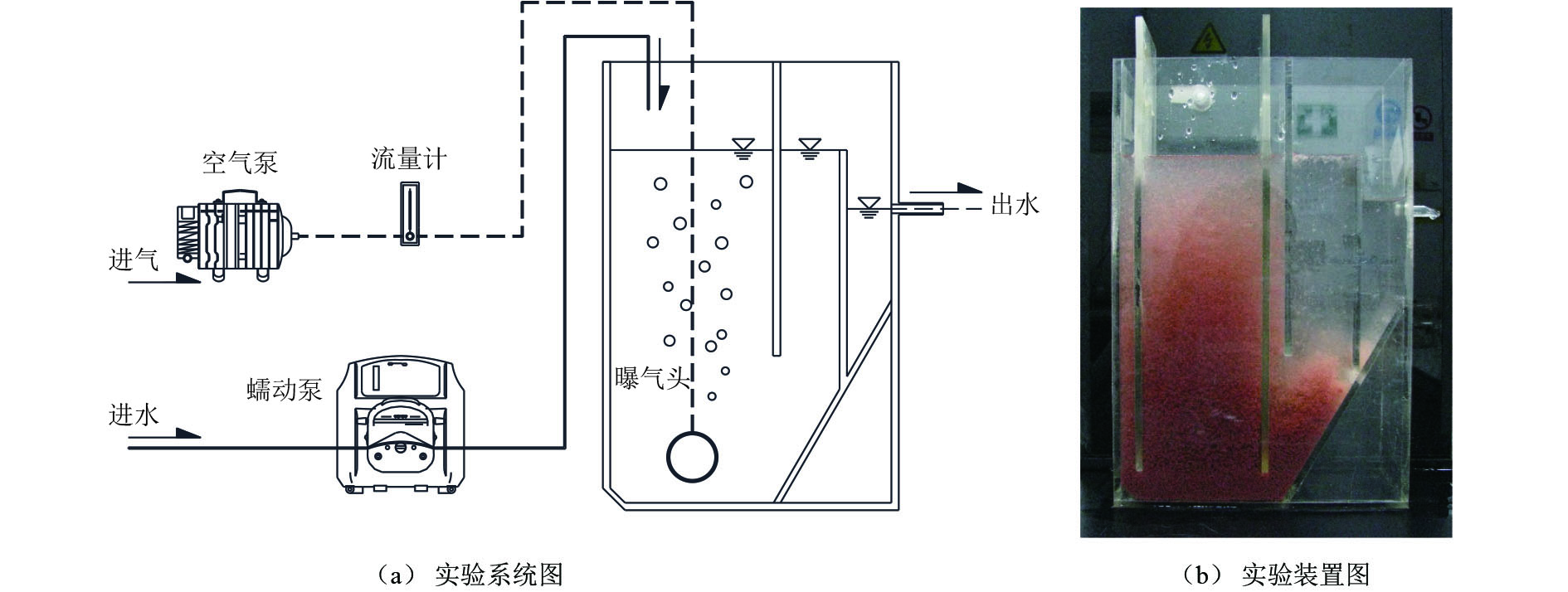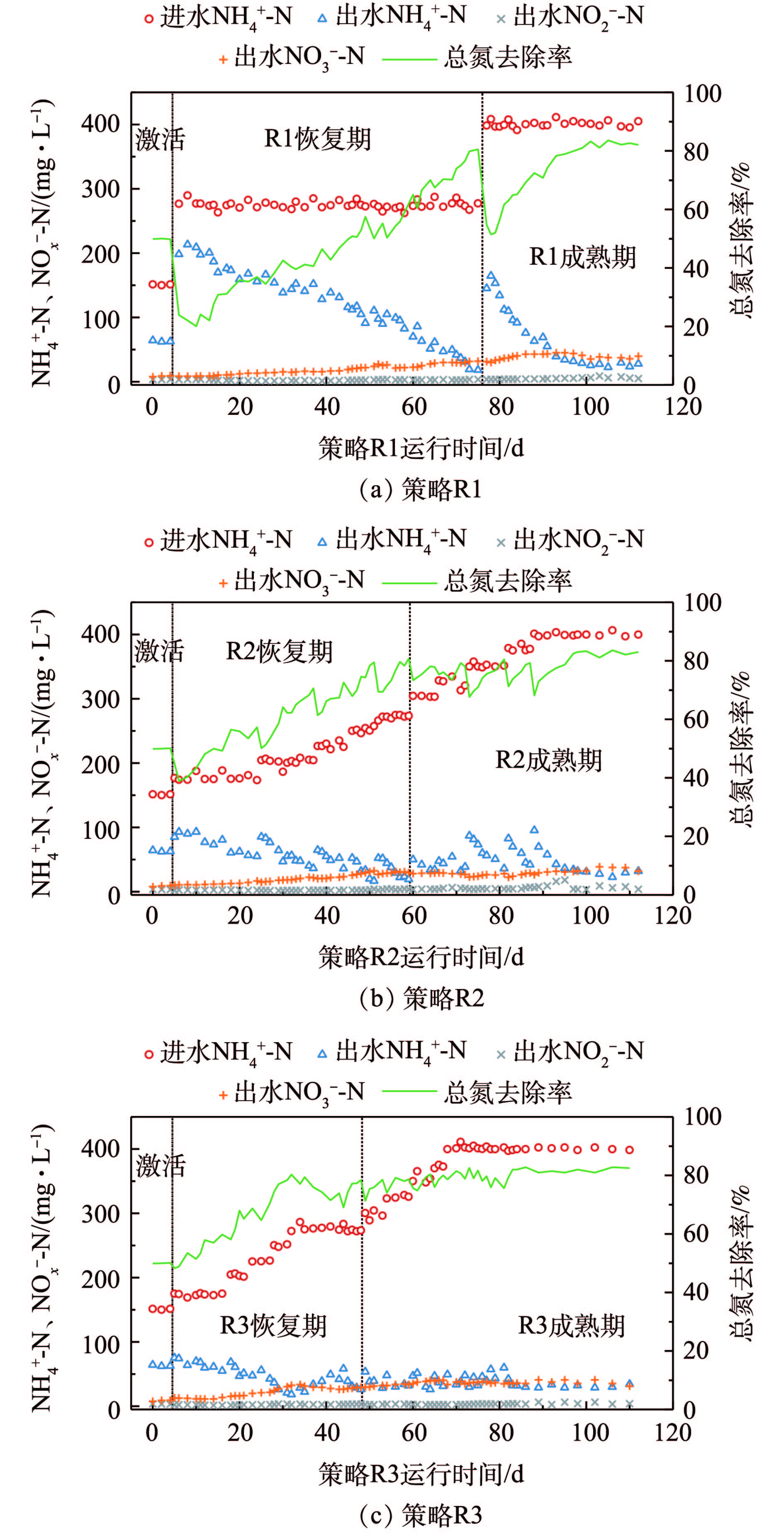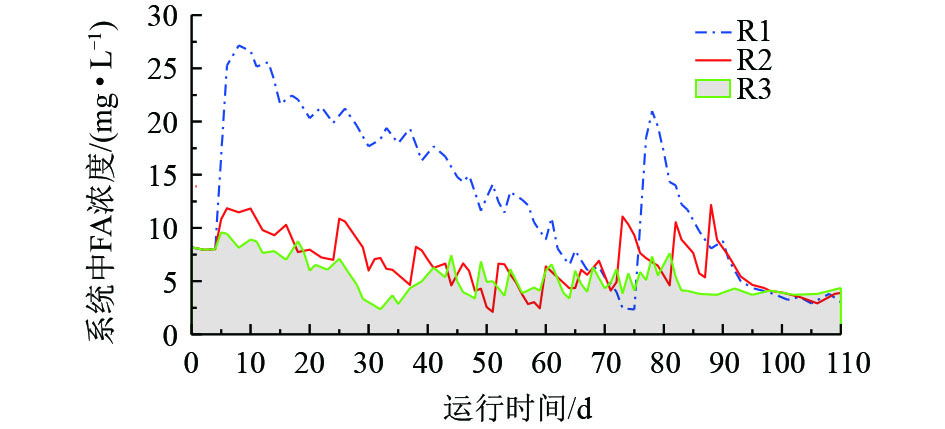-
随着水体富营养化的加剧和日益严格的排放标准,开发经济、高效、稳定的可持续生物脱氮技术已迫在眉睫。CANON (completely autotrophic nitrogen removal over nitrite)工艺较传统生物脱氮工艺可节约100%的有机碳源,降低约63%的曝气能耗,污泥产量减少约90%,且反应器结构简单、微生物受游离氨(FA)和游离亚硝酸(FNA)毒性小,成为目前最为经济有效的生物脱氮工艺[1],在垃圾渗滤液和污泥消化液这类高氨氮工业废水的脱氮处理中备受青睐[2-3]。CANON颗粒污泥基于好氧、缺氧空间分布和基质传质梯度维持AOB和AMX动态平衡,是实现CANON工艺稳定脱氮的关键[4]。CANON污泥中主要功能菌增殖较慢,如AMX世代时间为10~12 d[5],一旦颗粒污泥中AOB、AMX和亚硝酸盐氧化菌(NOB)等功能微生物的协同与制约作用被破坏,污泥性能恢复调控难度大。
在实际工程应用中,水质变化不可避免,易引起污泥活性抑制和微生物间平衡破坏,导致CANON颗粒污泥工艺运行调试周期长、难度大。如较高的进水氨氮浓度,对AMX和AOB都会有不同程度的抑制。DAPENA-MORA等[6]发现,当初始氨氮质量浓度为350 mg·L−1,AMX菌活性降低50%;李冬等[7]研究表明, 进水氨氮浓度从50 mg·L−1增加到200 mg·L−1后,AOB被抑制,致使亚硝化颗粒污泥胞外聚合物(PN)减少。因此,探索CANON颗粒污泥快速适应进水氨氮浓度提升的调控方法,是本技术工程化应用亟待研究的课题。
本研究以常温存储2个月的自养颗粒污泥为种泥,通过3种调控策略探究了全自养脱氮颗粒污泥快速适应高浓度氨氮的有效调控途径及重要影响因子。其中:策略R1为HRT不变,通过提高氨氮浓度来直接提升氨氮负荷;策略R2为HRT不变,逐级提高氨氮浓度,梯度增加氨氮负荷;策略R3为HRT与氨氮浓度同步,平稳提升氨氮负荷,
全文HTML
-
实验用水为人工配制的无机含氮废水,以氯化铵(NH4Cl)为氮源(以N计125~400 mg·L−1),通过投加碳酸氢钠(NaHCO3)提供碳源和碱度,调节pH为7.9~8.0,其他组分还包括44 mg·L−1磷酸二氢钾(KH2PO4)、20 mg·L−1六水合硫酸镁(MgSO4·7H2O)、0.15 mg·L−1六水合三氯化铁(FeCl3·6H2O)和1.0 mL微量元素溶液[8]。
-
实验装置为3个完全相同的完全混合流反应器(R1、R2和R3),单个反应器反应区和沉淀区的有效容积分别约为1.7 L和0.7 L,如图1所示。所有反应器均通过水浴控制温度在(30±1) ℃。
-
接种污泥取自实验室贮存的CANON颗粒污泥,表面呈黑褐色,平均粒径0.84 mm。进水氨氮浓度150 mg·L−1,维持HRT 1.5 h和DO约0.7 mg·L−1的条件下,激活4 d,反应器的总氮去除率为48%,总氮去除负荷为1.2 kg·(m3·d)−1。接种该性能颗粒污泥至R1、R2和R3,污泥浓度为6.0 g·L−1。
-
在R1、R2和R3完全相同的3个反应器,施行3种不同调控策略。实验分2个阶段,氨氮浓度提升幅度均为125 mg·L−1,第I阶段为污泥性能提升与稳定期,污泥适应进水氨氮浓度从150 mg·L−1到275 mg·L−1,在此阶段,同步恢复污泥活性和适应较高氨氮负荷。第II阶段为污泥成熟期,考察3种调控方式对污泥从进水氨氮275 mg·L−1到400 mg·L−1的适应影响。具体的运行策略如表1所示。
策略R1和R2维持HRT不变,探究氨氮浓度不同提升幅度对污泥性能的影响,策略R2与R3研究在相同的氨氮梯度下,通过HRT调节氮容积负荷,考察不同氨氮提升负荷对污泥性能的影响。
本实验以维持反应器出水f值(Δ
${\rm{NO}}_3^{-} $ NO3−-N/ΔTN)在理论值0.127左右[9-10]为DO调控依据,防止DO过量抑制AMX,也避免DO不足抑制AOB。 -
实验所用仪器为pH计(PB-10型,Sartorius公司);溶解氧测定仪(H1946N型,WTW公司)。
$ {\rm{NH}}_4^{+}$ -N、${\rm{NO}}_2^{-} $ -N、${\rm{NO}}_3^{-} $ -N和TN指标分别采用纳氏试剂分光光度法、N-(1-萘基)-乙二胺分光光度法、紫外分光光度法和碱性过硫酸钾消解-紫外分光光度法测定;水中FA的计算公式参见文献中的方法[11];混合液悬浮固体(MLSS)采用标准重量法测定。采用筛分法测算颗粒污泥的粒径均值。定期从反应器中取出部分污泥样品,经0.9% NaCl溶液反复清洗后,依次通过孔径为1.6、1.25、1.0、0.8、0.5、0.2 mm的分样筛,称量各筛网截留的污泥质量。根据样品总质量,计算各粒径区间所占比例和颗粒平均粒径。
比反应速率的测定:根据AMX工艺反应式(1)和CANON工艺反应式(2),基于氮平衡和化学计量数计算比总氮去除速率(SNRR)、比氨氮氧化速率(SAOR)和比亚硝酸盐氮氧化速率(SNOR)的计算[12]见式(3)~式(6)。
式中:SNRR为比总氮去除速率;SAOR为比氨氮氧化速率;SNOR为比亚硝酸盐氮氧化速率;C∆N为总氮损失浓度;
$C_{({\rm{NH}}_4^{+}\text{-} {\rm{N}}){\rm{in}}} $ 为进水氨氮浓度;$C_{({\rm{NH}}_4^{+}\text{-} {\rm{N}}){\rm{out}}} $ 为出水氨氮浓度;$C_{({\rm{NH}}_4^{+}\text{-} {\rm{N}}){\rm{out}}} $ 为为出水硝酸盐氮浓度;CMLSS为污泥浓度;t为反应时间。
1.1. 实验用水
1.2. 实验装置
1.3. 接种污泥
1.4. 实验方法
1.5. 分析方法
-
策略R1(5~75 d)效能变化如图2(a)所示。运行初期,尽管出水氨氮浓度逐渐下降,但R1效能恢复缓慢,由于微生物不能适应基质浓度突然升高,长达44 d,出水氨氮浓度仍高于130 mg·L−1,总氮去除率低于45%。这期间反应器中FA浓度为16.6~26.7 mg·L−1,高浓度FA不利于污泥性能恢复。直到第75 d,总氮去除率达到80%以上,去除负荷为3.5 kg·(m3·d)−1,系统可适应较高氨氮负荷。
策略R2(5~59 d)适应进水氨氮浓度提升过程中氮形态的转化如图2(b)所示。每次氨氮浓度的提升,都会引起出水氨氮浓度的波动。前2次提升均需20 d左右总氮去除率才能接近80%;污泥性能较稳定后,氨氮浓度从200 mg·L−1逐级提升到275 mg·L−1,每次仅需8~10 d系统总氮去除率即可稳定在80%以上,适应期缩短一半。R2历时55 d,系统稳定适应较高氨氮负荷,总氮去除率可达到81%,去除负荷为3.5 kg·(m3·d)−1。
策略R3(5~48 d)调控过程中氮的转化规律如图2(c)所示。污泥对进水浓度变化没有明显的适应期,出水氨氮浓度均低于70 mg·L−1,且持续降低。第35天,总氮去除率已达到80%。当系统适应进水氨氮浓度为275 mg·L−1后,将HRT由2.0 h逐渐缩短至1.5 h。第48天,总氮去除率可达到80%,去除负荷达到3.5 kg·(m3·d)−1。
-
策略R1在成熟期(76~100 d)氮转化情况如图2(a)所示。由于氮负荷从4.40 kg·(m3·d)−1突然提高到6.40 kg·(m3·d)−1,在第77天,氨氮去除率相对于进水氨氮浓度为275 mg·L−1时,由81%下降至61%,出水氨氮浓度高达150 mg·L−1。但总的来说,功能微生物活性未受显著抑制,10 d后,氨氮去除率逐渐提高到81%,总氮去除率约达70%。相对于第I阶段,此阶段系统中功能微生物大量富集,且AOB和AMX比反应速率比恢复初期高约1倍,对基质浓度提升的适应性显著增强。历时仅25 d,总氮去除率达到83%,总氮去除负荷为5.3 kg·(m3·d)−1,在这种工况条件运行,反应器性能非常稳定。
策略R2在成熟期(60~99 d)氮转化情况如图2(b)所示。与第I阶段类似,每次进水氨氮浓度提升,去除率均有小幅下降,7 d左右即可适应氨氮负荷的提升,系统氨氮去除率可达90%左右,总氮去除率达80%。40 d后,进水氨氮浓度高达400 mg·L−1,总氮去除率稳定达到83%,总氮去除负荷为5.3 kg·(m3·d)−1。
策略R3在成熟期阶段(49~84 d)氮的转化如图2(c)所示。相比策略R2,负荷变化幅度更小,整个过程中出水氨氮都低于50 mg·L−1,且波动更小,总氮去除率基本维持在75%以上。尽管HRT降低,出水水质会出现小的波动,但系统在35 d后,总氮去除率和去除负荷分别可达82%和5.3 kg·(m3·d)−1,运行效果稳定。
采用3种不同调控策略使贮存CANON颗粒污泥2次快速适应高浓度氨氮,在污泥性能恢复和微生物富集培养阶段,策略R3逐级提高进水浓度的同时且适当延长HRT降低氨氮负荷,可减少高浓度氨氮对微生物的抑制,有利于系统性能平稳提升,缩短性能恢复时间;当功能微生物富集度较高,污泥性能成熟时,系统抗冲击负荷性能较强,策略R1可快速适应高浓度氨氮。总之,当污泥处于性能提升期,应采取平稳提升氨氮浓度的策略;当污泥处于性能成熟后,可快速提升氨氮浓度,缩短污泥适应高氨氮基质的时间。
-
通过序批实验考察3种调控策略在不同阶段污泥功能微生物活性,反应器性能提升过程中功能微生物的活性变化如表2所示。第9天时的批次实验结果表明,策略R2和策略R3在合适的DO条件下,微生物活性逐渐提升,策略R3相对于策略R2氨氮负荷变化更加平稳,具有更高的微生物活性。R1中微生物活性反应速率下降约25%,这说明氨氮负荷突然升高对微生物活性有一定的抑制作用。
第43天时,策略R2和策略R3污泥中功能微生物活性均有大幅提高,SNRR分别提高了87%和94%,SAOR分别提高了90%和98%。这一结果表明,策略R2和策略R3(尤其R3)有利于颗粒污泥中功能微生物性能提升,且很好地促进了AOB和AMX的协同。AOB良好的性能可为AMX提供合适的基质比,同时快速消耗DO,为AMX创造良好的生境;AMX活性的提升可降低系统中高浓度基质对AOB的抑制。R1功能微生物的SNRR和SAOR偏低,但随着出水氨氮浓度降低,AOB和AMX活性得以恢复。在相同氨氮浓度下,陈希等[13]研究的结果表明,SNRR可高达15.6 mg·(g·h)−1,高出本研究约30%。WINKLER等[14]发现微生物SNRR为14.3 mg·(g·h)−1。这表明本研究中功能微生物的活性仍有进一步的提高空间。
系统在第II阶段适应更高氨氮负荷,第85天时策略R2和策略R3中功能微生物活性分别比第43天时提高约20%~30%,R1微生物的SNRR达到16.9 mg·(g·h)−1,比第43天时提升了近1倍,提高氨氮浓度的策略可进一步提高AOB、AMX的活性[15-16],微生物SNRR和SAOR与系统脱氮效能的变化规律较好地吻合。
策略R1、R2和R3分别在第I阶段的第75、60和43天,以及在第II阶段105 d的稳定状态下,微生物比降解速率和总氮去除负荷非常相近,功能微生物的活性与调控方式无关,与运行条件、去除负荷有关。
此外,策略R1亚硝酸盐氮比氧化速率最低,策略R3亚硝酸盐氮比氧化速率相对要高(未给出),这主要与剩余氨氮浓度、HRT有关。通常,较高剩余氨氮、较短的HTR可降低NOB活性[17-18]。有研究[19]表明,剩余氨氮高于2~5 mg·L−1 即可抑制NOB,策略R1在氨氮快速提升过程中,较高的剩余氨氮可有效抑制NOB,导致SNOR下降。策略R3因较长的HRT不利于絮体的淘洗,但并未造成NOB过度增殖。
-
不同时期污泥粒径与浓度见图3。运行初期(第9天),污泥适应较高氨氮负荷,反应器絮体增多,污泥浓度下降,颗粒污泥平均粒径变小。这是由于久置的CANON颗粒污泥中微生物内源代谢,致使部分污泥水解,颗粒结构松散,接种初期在水力作用下不断摩擦而被洗出[20-21]。其中,策略R1下的污泥系统难以适应基质浓度突然升高,颗粒解体更为严重,微生物流失较多。
运行至第43天,各反应器中颗粒污泥粒径与浓度均增大,但3种调控策略对粒径与浓度的增长并无显著差异。R1颗粒污泥粒径略大,R3污泥浓度略高。R1平均粒径为0.92 mm,这归因于策略R1的高负荷运行有利于颗粒污泥粒径的增长[22]。良好的水力选择压有利于颗粒与絮体的分离,并不断淘洗,加之较高氨氮和较短HRT可促进微生物分泌胞外聚合物,从而促进污泥颗粒化[23]。策略R3 HRT长期维持在1.5~2.0 h,降低氨氮负荷升高对微生物影响。尽管较高的HRT有利于污泥截留,R3污泥浓度为7.11 g·L−1,但颗粒污泥平均粒径相对偏小。有研究表明,颗粒污泥粒径较小,有利于提高比表面积,提高微生物脱氮活性[24],R3的污泥性能稳定提升与污泥浓度、粒径的变化规律一致。
第Ⅱ阶段,颗粒粒径都有明显地增长,但基本不受调控策略的影响。污泥浓度都有显著提高,策略R3污泥浓度相对较高,第85天时污泥浓度达到9.0 g·L−1,与前面提到的调控策略R3有较好的污泥截留能力有关。
-
污水中的氨氮以游离氨(NH3)和铵根离子(NH4+)的形式存在[25],FA因不带电荷更容易通过细胞膜扩散进入细胞内并改变细胞质pH,中和膜电位,抑制各种氧化还原酶,或影响所涉及的电子转移和质子转移过程中酶的活性[26-27]。LI等[28]研究发现,FA高于20 mg·L−1会抑制AOB和AMX活性,导致CANON系统恶化,尤其是对AMX影响明显,FA的抑制质量浓度为20~25 mg·L−1[29];WAKI等[30]指出FA超过13~90 mg·L−1,会抑制AMX的活性。QIAN等[31]将FA浓度从0 mg·L−1增加到16.82 mg·L−1时,AOB活性降低了15.9%。
在3种调控策略运行过程中,FA的浓度变化见图4。策略R2进水氨氮以25 mg·L−1梯度提升,FA浓度始终低于11.5 mg·L−1。策略R3进水氨氮负荷变化更加平稳,FA低于8.9 mg·L−1,对AMX、AOB的抑制作用较小。而策略R1第I阶段,进水氨氮浓度直接提升至275 mg·L−1,前45 d的FA浓度为16.6~26.7 mg·L−1。由于高浓度FA对微生物的抑制,反应器效能恢复缓慢,这与LI等[28]研究结果较吻合。直到第45天后,出水氨氮低于130 mg·L−1,FA浓度低于16.6 mg·L−1,逐渐降低对微生物抑制,系统总氮去除率快速升高。R1恢复期比R2长约30%,比R3长约60%。
策略R1第II阶段,进水氨氮浓度再次提高125 mg·L−1,最高FA达18.5 mg·L−1,但系统并未出现显著抑制,24 d后,总氮去除率达到83%,总氮去除负荷为5.3 kg·(m3·d)−1。在此阶段,策略R1适应高进水氨氮负荷时间明显少于R2和R3,其原因为:1)功能微生物活性较高,具有强大的适应能力,FA浓度在一周内降低至12.6 mg·L−1以下;2)污泥浓度提高,在一定程度上降低了单位质量活性污泥接受FA的量[32],系统耐冲击负荷能力进一步提升;3)污泥粒径的增大和微生物富集,为AMX和AOB适应高FA提供良好的空间结构。
-
控制合理的DO是保证颗粒污泥内部各类功能微生物平衡的重要条件。由于AOB和AMX在CANON颗粒污泥不同空间分布,需要维持颗粒外层AOB所需足够的DO,确保稳定的亚硝化反应速率,为AMX生长提供充足的亚硝酸盐氮(
${\rm{NO}}_2^{-} $ -N)[16]。但过高的DO会渗透进入颗粒污泥内层,抑制AMX活性,同时NOB利用生成的${\rm{NO}}_2^{-} $ -N生长繁殖,消耗AMX所需的${\rm{NO}}_2^{-} $ -N基质[33]。本实验过程中,以f值作为DO调控参数,维持DO在合理范围,使得颗粒内部AOB和AMX获得良好的协同生长,NOB被有效抑制。结果表明,在不同策略下,总氮去除负荷由1.2 kg·(m3·d)−1升高至5.3 kg·(m3·d)−1过程中所需维持DO的变化关系如图5所示。DO逐渐从0.8 mg·L−1提升至2.6 mg·L−1,氨氮去除负荷与溶解氧浓度呈正相关关系,与孙延芳等[23]和张姚等[34]的研究结果一致。R1、R2和R3的平均f值分别为0.119、0.121和0.128,与理论值[9-10]较接近。这表明硝酸盐氮(
$ {\rm{NO}}_3^{-}$ -N)主要是由AMX脱氮产生的副产物,NOB活性已被有效抑制。根据总氮去除负荷调控DO,可既满足颗粒污泥中AOB对DO的需求,又有效促进AMX和AOB协同作用。因此,在运行CANON颗粒污泥工艺过程中,可以根据反应器总氮去除负荷来调节系统所需维持的DO浓度。当反应器因进水水质的变化等原因引起反应器去除负荷波动,可及时调整曝气量匹配合适的DO浓度,提高系统运行稳定性。
2.1. 不同调控策略对CANON工艺效能的影响
2.1.1. 第I阶段污泥性能提升与恢复期,CANON污泥适应进水氨氮浓度增幅125 mg·L−1的效能变化
2.1.2. 第II阶段污泥成熟期,CANON污泥适应400 mg·L−1氨氮废水的效能变化
2.2. 不同调控策略对CANON颗粒污泥性能变化的影响
2.2.1. 功能微生物活性变化
2.2.2. 污泥粒径与污泥浓度
2.3. 不同策略下CANON工艺快速适应高氨氮负荷的影响因素
2.3.1. 游离氨对快速适应高氨氮负荷的影响
2.3.2. DO对快速适应高氨氮负荷的影响
-
1)污泥性能提升期,采用氨氮负荷平稳提升的策略系统适应期最短,R3仅44 d总氮去除率达到80%,去除负荷达到3.4 kg·(m3·d)−1。污泥性能成熟期,策略R1仅需25 d,适应氨氮负荷6.4 kg·(m3·d)−1,总氮去除率达到83%,去除负荷达到5.3 kg·(m3·d)−1。因此,在污泥活性提升期应平稳提升负荷,功能微生物富集度后,可快速提升进水氨氮,缩短污泥适应高浓度基质的时间。
2)各种调控策略对功能微生物降解活性无显著性影响,逐渐适应高进水氨氮浓度运行过程中,污泥浓度和颗粒粒径均逐渐增大。
3)策略R1在氨氮负荷快速提升初期,FA浓度为16.6~26.7 mg·L−1,导致AOB和AMX活性受抑制。氨氮负荷稳步提升的策略R2和R3,可消除高浓度FA对微生物的抑制,应控制FA低于16.6 mg·L−1。
4) f值(Δ
${\rm{NO}}_3^{-} $ -N/ΔTN)可作为DO调节的重要依据,不同调控策略下,DO与氨氮去除负荷呈良好的线性关系。总氮去除负荷由1.2 kg·(m3·d)−1升高至5.3 kg·(m3·d)−1,维持系统功能微生物平衡所需的DO从0.8 mg·L−1提升至2.6 mg·L−1。






 下载:
下载:





